
FILTERS
Last updated: 25 July 2012
|
Solar Skreen Adaption (11/08/06) Lumicon ND 25 Filter (09/27/05) Personal Solar Telescope (06/29/06) V Block filter (10/04/03) Coronado White Light Solar Filter (3/15/03) SolarMax 40 H-Alpha (04/30/02) Color Filter #21, Orange (12/23/00) Color Filter #56, Light Green (12/23/00) Light Pollution Reduction filter (06/22/05) Various filters (11/04/98) Orion Narrowband filter (09/23/08) Solar II Type 2 Plus solar filter (1/16/98) Narrowband Filter Color Filter #8, Light Yellow |
Top 10 Telescope Filters for Better Observing (07/25/12) Meade 908N Nebula filter (01/31/06) Baader Neodymium Moon, Skyglow Filter (09/13/05) Lumicon UHC Filter (10/24/03) Planetary Contrast Filter (8/15/03) Meade Variable Polarizer Filter (07/27/02) AstroSolar Safety Film (03/15/03) 6-Pocket Filter Case (12/23/00) Moon Filter (11/12/00) Orion Solar Filter (09/12/04) Lumicon OIII deep-sky filter (05/21/98) Solar View Type A Plus solar filter (12/29/97) ETX SOLAR SKREEN (01/25/00) Color Filter #82A, Light Blue |
| Accessory | Manufacturer | Model | Price |
| UHC Filter | Lumicon | N/A | $100 |
|
Craig M. Bobchin (ETX_Astro_Boy@sbcglobal.net) provided the following: "For my 40th Birthday last month I bought myself a Lumicon UHC filter
with some gift money I received. I'd been wanting a nebula filter since
I got my ETX-105 a couple of years ago. The only question was which
one? After quite a bit of research, I settled on the Lumicon UHC filter.
With the closing of Lumicon earlier this year I had dispaired ever
getting one of their filters. Luckily they were resurrected a few months
ago by Parks Optics.
The UHC filter allows only the two doubly-ionized oxygen lines (496 and 501nm lines) and H-beta line (486nm) emitted by planetary and most emission nebulae, while blocking, completely the rest of the overall spectrum of light. This allows for a very deep contrast between the nebula being viewed and the rest of the sky. I was anxious to try it out, so on the 1st semi clear night I set my 105 light mug in the backyard to cool down. After an hour or so I went fuzzy hunting. Now without the filter my 105 has bagged such objects as M8, M20, M57, M42, and via averted vision M1 not to mention a few others. With the exception of M42 none of these really wowed me. However I was undaunted, I decided to try for the Triffid (M 20) and Lagoon (M8) nebula right off before they sank to low. They were in the murk, but the filter cut through it and there was the Triffid showing some structure. It actually looked like a small black and white version of the pictures I've seen of this beautiful sight. The Lagoon was equally impressive. When I took the filter off neither object was visible. M57 without the filter showed a small smudge that looked like a smoke ring. With the filter it popped into view and could not be missed by anyone. With the bad light pollution where I live I decided to stop hunting fuzzies for the evening. Besides I know that the coming weekend would give me ample time to play with my $100.00 piece of glass. That weekend I was headed up to Palomar mountain for an outreach called "Explore the Stars". This promised to give me good dark skies away from any light pollution, and I would be able to observe as long as I could stay awake. Perfect conditions to stretch the abilities of my light mug. I knew there would be other scopes there, Most bigger, but some smaller or the same size as my 4 inch ETX. This would also give me a chance to see how the filter handled other scopes. On almost every object looked at, the filter made a huge difference. I was not the only one to see it. The Dumbbell (M27) was an oval shape with brightening at the lobes, and the unfiltered view showed a smudge. Ditto for M57, M8 and a host of others. I wasn't able to make out the Veil Nebula with or without the filter. I even tried an OIII filter but had no luck. A 4 in APO refractor showed it nicely however. I'm still going to try for it later. The Orion Nebula was amazing without the UHC, But, when I added the filter I saw structure in the nebula I had never seen before. I was even able to see M1 (the Crab Nebula) directly. No averted vision needed. I decided to try it on some planets as well. It really made the markings on Mars stand out, but there was a price to pay. It gave this weird 3d glasses effect. Almost like I was looking through a pair of those red and blue glasses used at 3-d movies. It was a bit disconcerting. Saturn too showed better detail, as did Jupiter. But all with the extra red/blue images. So bottom line, is the Lumicon UHC filter worth the $99.00 + tax I paid for it? Without a doubt. It really makes the nebulae stand out. It suppresses all the extra light such as stars, light pollution etc... It enhances contrast, and gives you views you never thought possible. If you are on the fence about spending the money for this, I say go for it. You will only kick yourself for not doing it sooner." |
|||
| V Block filter | Orion | 05595 | $70 |
| Tim Haller (electra188@comcast.net) reports: "I have and use the V Block filter from Orion. The filter does work as advertised by controlling the fringing effect around bright objects like Mars, the moon and bright stars (1st magnitude or better). But the effect is very subtle. The filter certainly helps with chromatic aberration, but don't expect $4000 apochromatic refractor performance from the V Block with the ETX-70. I extract a lot of performance from my ETX-70 and can notice (and enjoy) the difference the V Block filter makes during my observations. If you observe just a few times a year, I don't think that the V Block will be of much use to you. Save the dough and buy a quality eyepiece that you can use with the 70 and any other scope that you might upgrade to in the future. Good luck - from a satisfied ETX-70 owner." | |||
| Planetary Contrast Filter | Coronado Sirius Optics | N/A | $75 |
| Kian Jek (kianjin@well.com) reports: "At a recent Star Party I was handed a Sirius Optics Planetary Contrast filter to try out. The view of Mars thru my ETX-125 at 211x was so good that I went ahead and bought one the very next day! The PC filter is unlike any other dyed or colored filter. I've always found colored filters, e.g. the yellow or light red ones for Mars somewhat "unnatural". But as many users here have pointed out, the current views of Mars are so bright that it is sometimes hard to make out fine details without resorting to one of these filters. The PC filter however, is designed to allow light to pass through in 3 narrow wavelengths, corresponding to the red, green and blue portions of the visual spectrum. The result is a subtle contrast enhancement and somehow images appear slightly sharper because of the selective filtering I guess. The image of Mars is slightly tinted yellowish in my opinion, but details are more discernable and most important, the view is closer to 'reality'. You can check out www.siriusoptics.com to find out more about the PC filter, and try googling around to find some reviews of it. The filter also improves views of Jupiter and Saturn, so I think it's something that all planetary enthusiasts should have in their accessory box." | |||
| White Light Solar Filter | Coronado Technology Group | W90 | $249 |
Coronado Technology Group sent me their new "Better White Light Filter" for the ETX-90. This high-end filter presents a natural yellow view of the Sun unlike the orange or blue look with other solar filters. This, combined with the screw-on style, makes for a quality solar filter for the serious white light solar observer. I like the safety that a screw-on solar filter provides. Once, while observing through another amateur's telescope, his solar filter blew off in the wind. Fortunately I jumped away from the eyepiece in time to avoid any eye damage. But this demonstrates how important it is to properly secure a solar filter; since the Coronado filter screws into the threads on the correcting lens of the ETX-90 this a very safe filter. As with any solar filter, you still need to cover the finderscope.
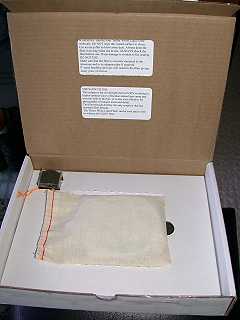 The filter comes in a box (as shown in the photo on the right) and includes a pouch for the main filter, a FeXIV (dark green) filter that screws into an eyepiece like a normal filter for faculae enhancement, and some sales literature. The two filters are shown in the photo on the left. The
The filter comes in a box (as shown in the photo on the right) and includes a pouch for the main filter, a FeXIV (dark green) filter that screws into an eyepiece like a normal filter for faculae enhancement, and some sales literature. The two filters are shown in the photo on the left. The 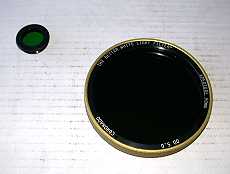 next photo shows the solar filter attached to the correcting lens of my ETX-90RA (the cardboard behind the filter is my "sunshade"). The specs from the Coronado Instruments website are: "Type: Optical Crown Glass, transmitted wavefront <1/4 wave, pinhole free, double coated iconel". I found that a lot of detail was visible in both the 26mm and a 9.7mm eyepieces. Although the Sun
next photo shows the solar filter attached to the correcting lens of my ETX-90RA (the cardboard behind the filter is my "sunshade"). The specs from the Coronado Instruments website are: "Type: Optical Crown Glass, transmitted wavefront <1/4 wave, pinhole free, double coated iconel". I found that a lot of detail was visible in both the 26mm and a 9.7mm eyepieces. Although the Sun  was rather quiet when I first used the filter there was a nice small sunspot group near the center of the solar disk and another grouping near the limb. The details near the limb were very impressive. With the FeXIV filter attached to an eyepiece, the image dims somewhat but the contrast increase is evident, especially in the 26mm. Here are two photos taken with a Nikon Coolpix 995, a Scopetronix 25mm eyepiece, and the Scopetronix Digi-T adapter. They show the color difference with and without the green filter attached. I will add more (and better) photos to my Astrophotography Gallery - The Sun page as I take them.
was rather quiet when I first used the filter there was a nice small sunspot group near the center of the solar disk and another grouping near the limb. The details near the limb were very impressive. With the FeXIV filter attached to an eyepiece, the image dims somewhat but the contrast increase is evident, especially in the 26mm. Here are two photos taken with a Nikon Coolpix 995, a Scopetronix 25mm eyepiece, and the Scopetronix Digi-T adapter. They show the color difference with and without the green filter attached. I will add more (and better) photos to my Astrophotography Gallery - The Sun page as I take them.
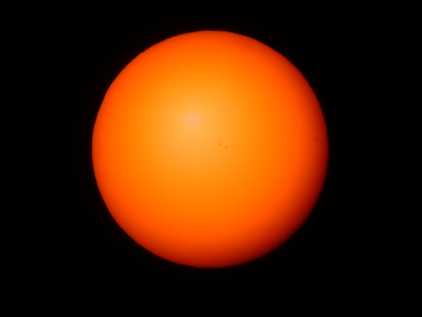 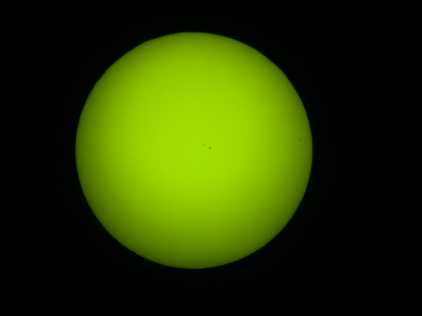
Mike here: I took some photos of a naked eye sunspot; you can see them on my Astrophotography Gallery - Sun page. |
|||
| SolarMax 40 H-alpha Solar Filter | Coronado Technology Group | N/A | $800 (approx) |
|
On Saturday, 6 January 2001, I and many others had a sneak preview of a new, low-cost Hydrogen-alpha solar filter from Coronado Manufacturing. David Lunt came to Oceanside Photo & Telescope to show off their new amateur solar filter. Unlike other solar filters which just reduce the Sun's light and harmful radiation passing through your telescope letting you view sunspots and some other "white-light" details, H-alpha filters let you see our Sun in all its glory, including prominences visible on the limb (which would normally require a total solar eclipse to be seen). H-alpha filters work by passing a very narrow and specific frequency band and blocking out everything else. The Sun comes alive for you when viewing through one of these filters. In the past, these filters have been very expensive (at least 2-3 times the cost of an ETX-125EC) but this new model, expected to cost about $800, brings H-alpha viewing to a much wider amateur astronomy audience. The filter actually consists of two filters: a 40mm filter that covers the aperture of your telescope (using an adapter plate) and an eyepiece filter (attaches to the eyepiece like other eyepiece filters). During this sneak preview there was a very large prominence (a "rainbox-shaped arc" one) that was easily visible at all magnifications. The view of details on the Sun's disk was very sharp. The filter was attached to a small refractor, which actually made for a fine solar instrument. According to David Lunt, the ETX-60AT and ETX-70AT will perform really well with the new filter. The ETX-90EC and ETX-125EC models can also be used but since both are longer focal length telescopes than the -60/-70 models, stopping them down to the 40mm aperture of the filter will make the solar image dimmer. For the -90/-125 models, the filter will be offset to avoid the blockage of the secondary mirror. Coronado will have adapter plates for nearly every popular telescope model and the new filter is expected to be available in April 2001. Take a look at the solar images on Coronado's web site (http://coronadofilters.com/) to see examples of what you can expect to see with the new filter. If you are as intrigued by this as I am, Oceanside Photo & Telescope is accepting pre-orders; contact Mike Fowler at 800-483-6287, 760-722-3343, or opt@optcorp.com to get on their list. I hope to have a more extensive actual usage review online as soon as I can get one of the new filters. Thanks to Oceanside Photo & Telescope for setting up this sneak preview.
The following clarifications have been received from Coronado: Sent: Thursday, January 11, 2001 18:57:45 "Coronado Instruments Ltd. has developed a 40mm H alpha filter for Solar observing. This filter will be on the market late April and the company is attempting to retail the filter at below $1,000.00. At a recent demo of the filter at OPT , Gerry Hogan, speaking for Coronado announced that they are seraching for a name for this new filter and that they will take suggestions at a sun@coronadofilters.com. If they select and use a name submitted by a member of the public, they will reward that person with one of the filters. The name will become the sole property of Coronado Instruments Ltd." Mike here: I'm still trying to get one but in the meantime here is a short report from Vincent (vincent_ysc1@yahoo.com): "First try of SolarMax 40 with ETX90EC,40mm eyepiece+X2 barlow. looking through from this filter have a exciting feeling, and also addicting." 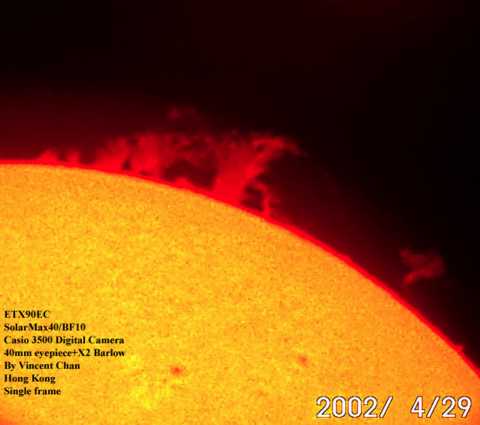
|
|||
| Baader Planetarium AstroSolar Safety Film | Astro-Physics, Inc. | N/A | $30 |
Glenn Smollinger (gsmollin@snip.net) tells us: "Sky and Telescope magazine did a review of the Baader Planetarium AstroSolar Safety Film, where they called it "the new standard". With the Dec. 25, 2000 solar eclipse loomimg, I bought it from the sole US distributor, Astro-Physics, Inc. The film is available in two sizes, A4, for $30, and a roll 1m X 500mm. I bought the former. It is also available in density 5 visual, and density 3.8 for photographic use. I bought the density five. You can cut the A4 size in half, and make a filter for the objective of the ETX90EC, and one for the 30mm finder scope. The included instructions show two different cells; use the instructions from Astro-Physics to make the objective filter. Its a better design, uses less filter material, and gives a nearly flat filter surface. Use the simpler Baader Planetarium design to make the filter cell for the finderscope. It will give a wrinkled surface, but who cares for a finderscope.
When pointing the telescope DO NOT LOOK AT THE SUN! Instead, examine the shadow of the telscope on a wall or screen, or even the ground. When the shadow of the OTA has been carefully minimized, look in the finderscope, and you will see the sun. I found that the 40 mm eyepiece was the best for viewing the eclipse. The atmospheric turbulence has pretty bad by 12:45 PM. The image was a neutral white, with sunspots clearly visible, including the penumbral brushes. I could use the 25 mm eyepiece as well, but found I was at the magnification limit with the 25 mm + 2X barlow due to turbulence. The most exciting moment was when I thought I could see sunlight streaming through a mountain valley on the moon right at the terminator of the eclipse. S&T reported seeing solar faculae on the suns surface, but I could not confirm this. Perhaps the turbulence was too great.
I can recommend this product. For $30 you can assemble two filters for ETX90 telescopes, including the finderscopes. With the half square meter size, a club can assemble filters for even less."
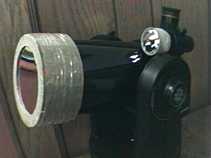 Glenn has supplied this photo of his setup.
Glenn has supplied this photo of his setup.
Michael Teige (mteige@yahoo.com) writes: "Today the Sun finally came out up here in Seattle! First try of my BAADER AstroSolar film mounted in my homemade filter cell with my ETX90 EC.  I bought it from www.astro-physics.com for $30.
The Sun was a nice natural white color with 3 sunspots
visible.
Only one was big enough to be seen really well.
The only eyepiece I currently own is the stock 26mm
Super Plossl with Meade's "shorty" Barlow.
I took a few pictures by simply holding my Canon
PowerShot A40 digital camera up to the Eyepiece so I'm
sure some vignetting happened.
Not the best way to take a picture, but good enough
for my purposes :)
The filter cell took me a couple of hours to make out
of stiff cardboard, but the end result was quite
satisfactory.
There were no spots that needed touching up when I
held it up to a bright lamp.
I used the instructions for making the cell supplied
by astro-physics.
I have also sent a picture of the cell on my scope.
I didn't bother to make a filter for the finderscope
so I just removed it from the scope and scanned the
sky for the Sun.
Maybe I'll make a filter for the finder later.
So far I am really pleased with the film and at only
$30 it was a nice bargain over the $80-$100 glass
filters and having seen the Sun through a Thousand
Oaks glass filter, it performed just as well if not
better.
So if you don't mind making the cell yourself, I
highly recommend this film.
For $30 you get enough to make 2 filters so the extra
is stored away for when and if I mess up the first
one.
I bought it from www.astro-physics.com for $30.
The Sun was a nice natural white color with 3 sunspots
visible.
Only one was big enough to be seen really well.
The only eyepiece I currently own is the stock 26mm
Super Plossl with Meade's "shorty" Barlow.
I took a few pictures by simply holding my Canon
PowerShot A40 digital camera up to the Eyepiece so I'm
sure some vignetting happened.
Not the best way to take a picture, but good enough
for my purposes :)
The filter cell took me a couple of hours to make out
of stiff cardboard, but the end result was quite
satisfactory.
There were no spots that needed touching up when I
held it up to a bright lamp.
I used the instructions for making the cell supplied
by astro-physics.
I have also sent a picture of the cell on my scope.
I didn't bother to make a filter for the finderscope
so I just removed it from the scope and scanned the
sky for the Sun.
Maybe I'll make a filter for the finder later.
So far I am really pleased with the film and at only
$30 it was a nice bargain over the $80-$100 glass
filters and having seen the Sun through a Thousand
Oaks glass filter, it performed just as well if not
better.
So if you don't mind making the cell yourself, I
highly recommend this film.
For $30 you get enough to make 2 filters so the extra
is stored away for when and if I mess up the first
one.
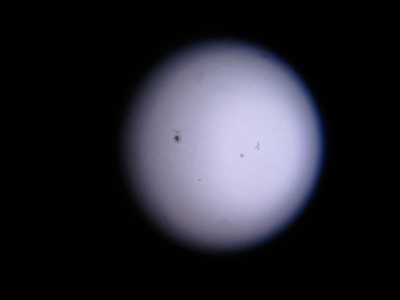
|
|||
| 6-Pocket Filter Case | Orion Telescopes & Binoculars | #15092 | $9 |
 With the addition of two more filters, bringing my total to six, I finally decided I needed something more convenient than individual filter cases. After looking through some catalogs and
With the addition of two more filters, bringing my total to six, I finally decided I needed something more convenient than individual filter cases. After looking through some catalogs and 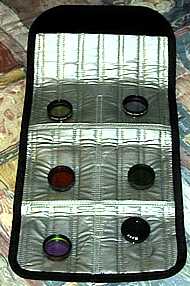 web sites I came across the Orion 6-Pocket Filter Case from Orion Telescopes & Binoculars. This soft-sided case holds six filters (0.965, 1.25, or 2-inch diameter), has a belt loop, and closes with velcro. It folds up as shown in the photo on the right and expands as shown in the photo on the left.
Also you can see the six filters inserted into their individual pockets. The back is a soft aluminum-like cloth with the plastic transparent front. Filters seem to be secure when inserted at least halfway into the filter pocket.
web sites I came across the Orion 6-Pocket Filter Case from Orion Telescopes & Binoculars. This soft-sided case holds six filters (0.965, 1.25, or 2-inch diameter), has a belt loop, and closes with velcro. It folds up as shown in the photo on the right and expands as shown in the photo on the left.
Also you can see the six filters inserted into their individual pockets. The back is a soft aluminum-like cloth with the plastic transparent front. Filters seem to be secure when inserted at least halfway into the filter pocket.

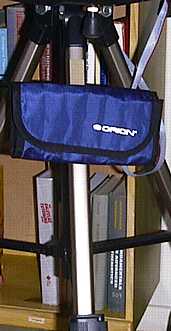
I decided to add some velcro to the belt loop so that I could attach the case to the velcro on my tripod. The photos on the right show the case closed and open. This works very well and puts all my filters within easy reach. |
|||
| Color Filter #21, Orange | Orion Telescopes & Binoculars | #5534 | $10 |
 Since my color filter collection was limited to just two (#8, Light Yellow; #82A, Light Blue) I felt like I needed to add some more capabilities to my viewing. After some research using the filter descriptions printed in the Orion Telescopes & Binoculars catalog (also available on their web site), I decided that I would get the best results using either the ETX-90RA or ETX-125EC with two filters. On the ETX-90RA, the #21 Orange Filter provided some better and crisper views of Jupiter's cloud bands, especially with the 26mm eyepiece. On Saturn, it gave a better view of the equatorial cloud band, with both the 26mm and 9.7mm eyepieces. With the ETX-125EC, Jupiter's cloud bands were more readily visible but there wasn't much contrast with the 26mm eyepiece and not much improvement with the 9.7mm eyepiece. On Saturn was where I saw the most difference: the equatorial cloud band was easily visible in the 9.7mm but less so with the 26mm eyepiece. I even tried Venus (about half phase) in the ETX-125EC. Without any filter it was almost blindingly bright in the 26mm eyepiece but with the Orange filter the phase was readily visible without squinting.
Since my color filter collection was limited to just two (#8, Light Yellow; #82A, Light Blue) I felt like I needed to add some more capabilities to my viewing. After some research using the filter descriptions printed in the Orion Telescopes & Binoculars catalog (also available on their web site), I decided that I would get the best results using either the ETX-90RA or ETX-125EC with two filters. On the ETX-90RA, the #21 Orange Filter provided some better and crisper views of Jupiter's cloud bands, especially with the 26mm eyepiece. On Saturn, it gave a better view of the equatorial cloud band, with both the 26mm and 9.7mm eyepieces. With the ETX-125EC, Jupiter's cloud bands were more readily visible but there wasn't much contrast with the 26mm eyepiece and not much improvement with the 9.7mm eyepiece. On Saturn was where I saw the most difference: the equatorial cloud band was easily visible in the 9.7mm but less so with the 26mm eyepiece. I even tried Venus (about half phase) in the ETX-125EC. Without any filter it was almost blindingly bright in the 26mm eyepiece but with the Orange filter the phase was readily visible without squinting.
|
|||
| #56 Light Green | Orion Telescopes & Binoculars | #5574 | $10 |
 Since my color filter collection was limited to just two (#8, Light Yellow; #82A, Light Blue) I felt like I needed to add some more capabilities to my viewing. After some research using the filter descriptions printed in the Orion Telescopes & Binoculars catalog (also available on their web site), I decided that I would get the best results using either the ETX-90RA or ETX-125EC with two filters. On the ETX-90RA, the #56 Light Green did a nice job on Venus (about half phase), even in the 9.7mm eyepiece. Jupiter had nice crisp cloud bands in the 26mm eyepiece with additional bands visible when using the 9.7mm eyepiece. I found Saturn too dim with the filter and 9.7mm eyepiece. On the ETX-125EC, instead of the unfiltered blindingly bright half phase Venus in the 26mm eyepiece, the filter provided nic views in both the 26mm and 9.7mm eyepieces. During moments of good seeing, there were many cloud bands visible on Jupiter with either the 26mm or 9.7mm eyepiece. Saturn really looked nice in the 9.7mm eyepiece, with many bands, the Cassini Division, and the Ring shadow on the planet all visible.
Since my color filter collection was limited to just two (#8, Light Yellow; #82A, Light Blue) I felt like I needed to add some more capabilities to my viewing. After some research using the filter descriptions printed in the Orion Telescopes & Binoculars catalog (also available on their web site), I decided that I would get the best results using either the ETX-90RA or ETX-125EC with two filters. On the ETX-90RA, the #56 Light Green did a nice job on Venus (about half phase), even in the 9.7mm eyepiece. Jupiter had nice crisp cloud bands in the 26mm eyepiece with additional bands visible when using the 9.7mm eyepiece. I found Saturn too dim with the filter and 9.7mm eyepiece. On the ETX-125EC, instead of the unfiltered blindingly bright half phase Venus in the 26mm eyepiece, the filter provided nic views in both the 26mm and 9.7mm eyepieces. During moments of good seeing, there were many cloud bands visible on Jupiter with either the 26mm or 9.7mm eyepiece. Saturn really looked nice in the 9.7mm eyepiece, with many bands, the Cassini Division, and the Ring shadow on the planet all visible.
|
|||
| Moon Filter | Scopetronix | N/A | $13 |
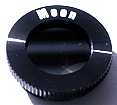 I purchased this filter from Scopetronix. I decided that after nearly 40 years of looking at the Moon without a filter I should give one a try. The Moon filter attaches to almost any 1-1/4" eyepiece. It is a neutral density filter, meaning there is no color shift, that reduces the
I purchased this filter from Scopetronix. I decided that after nearly 40 years of looking at the Moon without a filter I should give one a try. The Moon filter attaches to almost any 1-1/4" eyepiece. It is a neutral density filter, meaning there is no color shift, that reduces the 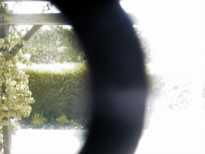 amount of light passing through (see the photograph on the left which shows an overexposed area on the right and a better exposed area on the left). My first night out with it the Moon was about 4 days old (crescent). With the standard 26mm eyepiece on the ETX-90RA the Moon without a filter was bright but not uncomfortably so. However, when adding the filter it was much easier to view details on the Moon without any tendency to squint. I also looked at Venus with the Moon filter and 26mm eyepiece and found the brightness of Venus reduced just enough to make its disk more obvious. I then tried the 9.7mm eyepiece, which by itself reduced the Moon's brightness significantly. I was somewhat surprised that with the (unnecessary) Moon filter, details were easily seen. I then tried the Scopetronix 40mm eyepiece in combination with the Shutan Wide Field Adapter. The Moon was almost bright enough at 4 days to be uncomfortable at this low magnification. But with the filter, looking at the Moon for long periods was a joy. A few days later I viewed the nearly First Quarter Moon using the 40mm, 26mm, and 9.7mm eyepieces on the ETX-125EC. Unfiltered, the Moon was difficult to look at for long periods with the 40mm and 26mm. By adding the filter to these eyepieces, details on the Moon could be viewed continuously without discomfort. With the 9.7mm eyepiece, the filter was not really necessary at this lunar phase but did not detract from the view. A few days before Full Moon I viewed the Moon with the ETX-90RA using the 40mm, 26mm, and 9.7mm eyepieces. Even with the smaller aperture, the Moon was bright enough with the 40mm and 26mm to make viewing somewhat uncomfortable. But with the Moon Filter, I could look at the Moon for long periods. With the 9.7mm eyepiece and the Moon Filter, the Moon at this phase was bright enough to make the use of the Filter worthwhile, even with the smaller aperture of the ETX-90RA. One side benefit to using the Moon Filter that I discovered was the reduction in the effects of thermals from a local roof. While some turbulence in the air was still evident with the filter, it seemed to be less destructive to the view. During a Full Moon I used the ETX-125EC. With the 26mm eyepiece, the Moon was definitely too bright to look at easily. And when I looked away from the telescope, there was a serious "after image" that made it difficult to see using that eye. With the Moon Filter attached, it was much easier to view the Moon although some after image remained. With the 9.7mm eyepiece, the Moon was still pretty bright without the filter and some after image resulted. With the filter, it was very comfortable to view details on the Moon and there was no after image. The final test was the 40mm eyepiece. Wow! Was the Moon ever bright through that eyepiece in the 5" telescope! It was really difficult to look at the unfiltered Moon and there was a major after image when looking away. With the Moon Filter, the Moon was still very bright (with a resulting after image) but I could observe much longer. The Full Moon was definitely a beautiful sight in the 40mm with the filter. Details were much easier to pick out as the glare was significantly reduced and contrast was increased. A Moon Filter can be compared to wearing sunglasses during the day to reduce glare and make seeing easier on the eyes. A Moon filter can definitely increase your enjoyment of studying our closest neighbor, even with the ETX-90. With a larger aperture telescope it is almost an essential accessory for serious lunar observing. The Scopetronix Moon Filter is of high quality. When holding the filter at an angle and looking through it, no optical distortions can be seen, indicating that the filter surfaces are flat and the glass is good optically. At this price, this is one item you should consider adding to your accessory pack.
amount of light passing through (see the photograph on the left which shows an overexposed area on the right and a better exposed area on the left). My first night out with it the Moon was about 4 days old (crescent). With the standard 26mm eyepiece on the ETX-90RA the Moon without a filter was bright but not uncomfortably so. However, when adding the filter it was much easier to view details on the Moon without any tendency to squint. I also looked at Venus with the Moon filter and 26mm eyepiece and found the brightness of Venus reduced just enough to make its disk more obvious. I then tried the 9.7mm eyepiece, which by itself reduced the Moon's brightness significantly. I was somewhat surprised that with the (unnecessary) Moon filter, details were easily seen. I then tried the Scopetronix 40mm eyepiece in combination with the Shutan Wide Field Adapter. The Moon was almost bright enough at 4 days to be uncomfortable at this low magnification. But with the filter, looking at the Moon for long periods was a joy. A few days later I viewed the nearly First Quarter Moon using the 40mm, 26mm, and 9.7mm eyepieces on the ETX-125EC. Unfiltered, the Moon was difficult to look at for long periods with the 40mm and 26mm. By adding the filter to these eyepieces, details on the Moon could be viewed continuously without discomfort. With the 9.7mm eyepiece, the filter was not really necessary at this lunar phase but did not detract from the view. A few days before Full Moon I viewed the Moon with the ETX-90RA using the 40mm, 26mm, and 9.7mm eyepieces. Even with the smaller aperture, the Moon was bright enough with the 40mm and 26mm to make viewing somewhat uncomfortable. But with the Moon Filter, I could look at the Moon for long periods. With the 9.7mm eyepiece and the Moon Filter, the Moon at this phase was bright enough to make the use of the Filter worthwhile, even with the smaller aperture of the ETX-90RA. One side benefit to using the Moon Filter that I discovered was the reduction in the effects of thermals from a local roof. While some turbulence in the air was still evident with the filter, it seemed to be less destructive to the view. During a Full Moon I used the ETX-125EC. With the 26mm eyepiece, the Moon was definitely too bright to look at easily. And when I looked away from the telescope, there was a serious "after image" that made it difficult to see using that eye. With the Moon Filter attached, it was much easier to view the Moon although some after image remained. With the 9.7mm eyepiece, the Moon was still pretty bright without the filter and some after image resulted. With the filter, it was very comfortable to view details on the Moon and there was no after image. The final test was the 40mm eyepiece. Wow! Was the Moon ever bright through that eyepiece in the 5" telescope! It was really difficult to look at the unfiltered Moon and there was a major after image when looking away. With the Moon Filter, the Moon was still very bright (with a resulting after image) but I could observe much longer. The Full Moon was definitely a beautiful sight in the 40mm with the filter. Details were much easier to pick out as the glare was significantly reduced and contrast was increased. A Moon Filter can be compared to wearing sunglasses during the day to reduce glare and make seeing easier on the eyes. A Moon filter can definitely increase your enjoyment of studying our closest neighbor, even with the ETX-90. With a larger aperture telescope it is almost an essential accessory for serious lunar observing. The Scopetronix Moon Filter is of high quality. When holding the filter at an angle and looking through it, no optical distortions can be seen, indicating that the filter surfaces are flat and the glass is good optically. At this price, this is one item you should consider adding to your accessory pack.
|
|||
| Light Pollution Reduction | Celestron | N/A | $69 |
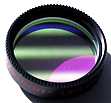 Even though my location is moderately dark, I decided to see if I could improve viewing of deep sky objects using a filter. I purchased a Celestron Light Pollution Reduction (LPR) filter from Scopetronix. The filter, shown on the right, attaches to the threads on the end of most eyepieces. (The dark bands are a reflection through a window.) It also comes with a rather good
Even though my location is moderately dark, I decided to see if I could improve viewing of deep sky objects using a filter. I purchased a Celestron Light Pollution Reduction (LPR) filter from Scopetronix. The filter, shown on the right, attaches to the threads on the end of most eyepieces. (The dark bands are a reflection through a window.) It also comes with a rather good
 explanation of how it works. As seen in the photo on the left, only certain wavelengths of light are allowed to pass through the filter. If the lighting in your area emits in the blocked wavelights (mercury and high and low sodium vapor lights as well as the natural sky glow due to neutral oxygen emission in the atmosphere), using the filter will result in improved views by increasing the contrast of the sky background and the object being viewed. According to the documentation supplied with the filter, the LPR passes over 90% of the desireable wavelengths which improves views of emission nebulae.
My first night out had lots of low clouds, but this allowed me to make a quick check of the filter's effectiveness. I looked at a local street light and its illumination was significantly reduced. Of course, any dark filter would do that. I then noticed there was a break in the clouds that allowed me to see the Summer Triangle (Vega, Deneb, and Altair). Holding the filter to my eye I looked through it at these stars. The surrounding clouds that were brightly illuminated by light pollution were reduced to faint clouds with only a slight reduction in the brightness of the stars. A few days later I got a brief chance to try the LPR out on a couple of real objects. I first viewed M57, the Ring Nebula in the constellation of Lyra. I first used the ETX-90RA. With the 26mm eyepiece, M57 was a small faint disk that barely stood out from the sky brightness. With the LPR added, M57 stood out much nicer from the sky background. I then looked at M57 with a 9.7mm eyepiece; I was surprised that M57 was actually still visible when the LPR was added but again it stood out nicely. However, it was sufficiently dim to make observing it less than exciting; it was much nicer in the 26mm eyepiece with the LPR. I then tried a Scopetronix 40mm eyepiece on the Shutan Wide Field Adapter; M57 was just a small dot and although contrast was increased with the LPR, it really didn't add anything to the view. From this brief experiment it was obvious that on a small aperture telescope like the ETX-90, the LPR really only works at lower magnifications and on bright objects. Since the LPR is a dark filter that reduces the amount of light passing through, this is to be expected. So I then tried it out on the ETX-125EC. Again I viewed M57, with the LPR on both the 26mm and 9.7mm eyepieces. At both magnifications M57 was really nice. What shocked me though was that in the 9.7mm eyepiece (196x), there were varying brightnesses in the ring and the central dark area was very dark. The LPR really added to the view of M57. Then I told the Autostar to GOTO M31, the Great Galaxy in Andromeda. In the 26mm eyepiece without the LPR, M31 appeared as a bright fuzzy patch with no discernable structure. With the LPR, the size of the fuzzy patch was reduced somewhat but there was a hint of structure. I then tried the 9.7mm eyepiece; without the LPR M31 remained a bright fuzzy patch but with the LPR, it was reduced to a faint blob. Opinion: disappointing in the 9.7mm but nice in the 26mm eyepiece. A few days later, I tried the LPR on several more objects using the ETX-125EC. First was Jupiter. For comparison I tried the Meade Photo-Visual Color Filter #82A (light blue), which helps to view cloud bands. Certainly there were more bands visible in the 9.7mm eyepiece with the light blue filter than without. But when I switched to the LPR on the 9.7mm eyepiece, an even greater number of cloud bands became visible. With the light blue filter on the 9.7mm, similar results occurred on Saturn; the planet's shadow was easily visible on the Rings. Nice. But when the LPR was used, the view of Saturn was really too dim to be usable. I then asked the Autostar to show me "Tonight's Best" with the following results using the LPR and 26mm eyepiece. M42, the Great Nebula in Orion: quite a bit more nebulosity and details (dark lanes) were visible than without the LPR. Horsehead Nebula: even though some users have seen this nebula visually, I could not. M45, Pleiades: I could almost believe I was seeing nebulosity around some of the stars; impressive. M32, companion to M31 in Andromedia: nice fuzzy dot. Double Cluster in Perseus: really nice. M1, the Crab Nebula in Taurus: I would likely have missed it without the LPR; with the LPR it really stood out as a large fuzzy patch. I then went back to M42 and used the 40mm eyepiece on the ETX-125EC. This wider view really showed the extent of the nebulosity, especially when the LPR was added. The LPR is of high quality. When holding the filter at an angle and looking through it, no optical distortions can be seen, indicating that the filter surfaces are flat and the glass is good optically. Bottom line: this Light Pollution Reduction filter may help you see more objects and more details from your location than would otherwise be possible. I don't think it is a worthwhile addition if you have an ETX-90 or smaller, but if you have a larger telescope and a bright sky, you might want to consider the LPR.
explanation of how it works. As seen in the photo on the left, only certain wavelengths of light are allowed to pass through the filter. If the lighting in your area emits in the blocked wavelights (mercury and high and low sodium vapor lights as well as the natural sky glow due to neutral oxygen emission in the atmosphere), using the filter will result in improved views by increasing the contrast of the sky background and the object being viewed. According to the documentation supplied with the filter, the LPR passes over 90% of the desireable wavelengths which improves views of emission nebulae.
My first night out had lots of low clouds, but this allowed me to make a quick check of the filter's effectiveness. I looked at a local street light and its illumination was significantly reduced. Of course, any dark filter would do that. I then noticed there was a break in the clouds that allowed me to see the Summer Triangle (Vega, Deneb, and Altair). Holding the filter to my eye I looked through it at these stars. The surrounding clouds that were brightly illuminated by light pollution were reduced to faint clouds with only a slight reduction in the brightness of the stars. A few days later I got a brief chance to try the LPR out on a couple of real objects. I first viewed M57, the Ring Nebula in the constellation of Lyra. I first used the ETX-90RA. With the 26mm eyepiece, M57 was a small faint disk that barely stood out from the sky brightness. With the LPR added, M57 stood out much nicer from the sky background. I then looked at M57 with a 9.7mm eyepiece; I was surprised that M57 was actually still visible when the LPR was added but again it stood out nicely. However, it was sufficiently dim to make observing it less than exciting; it was much nicer in the 26mm eyepiece with the LPR. I then tried a Scopetronix 40mm eyepiece on the Shutan Wide Field Adapter; M57 was just a small dot and although contrast was increased with the LPR, it really didn't add anything to the view. From this brief experiment it was obvious that on a small aperture telescope like the ETX-90, the LPR really only works at lower magnifications and on bright objects. Since the LPR is a dark filter that reduces the amount of light passing through, this is to be expected. So I then tried it out on the ETX-125EC. Again I viewed M57, with the LPR on both the 26mm and 9.7mm eyepieces. At both magnifications M57 was really nice. What shocked me though was that in the 9.7mm eyepiece (196x), there were varying brightnesses in the ring and the central dark area was very dark. The LPR really added to the view of M57. Then I told the Autostar to GOTO M31, the Great Galaxy in Andromeda. In the 26mm eyepiece without the LPR, M31 appeared as a bright fuzzy patch with no discernable structure. With the LPR, the size of the fuzzy patch was reduced somewhat but there was a hint of structure. I then tried the 9.7mm eyepiece; without the LPR M31 remained a bright fuzzy patch but with the LPR, it was reduced to a faint blob. Opinion: disappointing in the 9.7mm but nice in the 26mm eyepiece. A few days later, I tried the LPR on several more objects using the ETX-125EC. First was Jupiter. For comparison I tried the Meade Photo-Visual Color Filter #82A (light blue), which helps to view cloud bands. Certainly there were more bands visible in the 9.7mm eyepiece with the light blue filter than without. But when I switched to the LPR on the 9.7mm eyepiece, an even greater number of cloud bands became visible. With the light blue filter on the 9.7mm, similar results occurred on Saturn; the planet's shadow was easily visible on the Rings. Nice. But when the LPR was used, the view of Saturn was really too dim to be usable. I then asked the Autostar to show me "Tonight's Best" with the following results using the LPR and 26mm eyepiece. M42, the Great Nebula in Orion: quite a bit more nebulosity and details (dark lanes) were visible than without the LPR. Horsehead Nebula: even though some users have seen this nebula visually, I could not. M45, Pleiades: I could almost believe I was seeing nebulosity around some of the stars; impressive. M32, companion to M31 in Andromedia: nice fuzzy dot. Double Cluster in Perseus: really nice. M1, the Crab Nebula in Taurus: I would likely have missed it without the LPR; with the LPR it really stood out as a large fuzzy patch. I then went back to M42 and used the 40mm eyepiece on the ETX-125EC. This wider view really showed the extent of the nebulosity, especially when the LPR was added. The LPR is of high quality. When holding the filter at an angle and looking through it, no optical distortions can be seen, indicating that the filter surfaces are flat and the glass is good optically. Bottom line: this Light Pollution Reduction filter may help you see more objects and more details from your location than would otherwise be possible. I don't think it is a worthwhile addition if you have an ETX-90 or smaller, but if you have a larger telescope and a bright sky, you might want to consider the LPR.
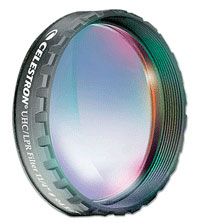 Wilo Laboy (wilolaboy@yahoo.com) adds: "I recently purchased a Celestron UHC/LPR filter from Adorama and here is my review. Price: $65
Description: The Celestron UHC/LPR block most of the artificial light and sky glow in light polluted areas. With my ETX-125EC, the filter performs very well with some nebulas, like Lagoon (M8), Trifid (M20) and some star clusters; but it's not strong enough to reveal all of the nebulosity of these nebulas (not picture like). Celestron says the peak transmission of the filter is 97%, but its decreases substantially star brightness (Vega looked one third dimmer) and everything looked green (like a night vision scope). It's kind of cool, but the filter didn't help the galaxies at all. I think the filter will perform better in less polluted skies, but this makes no sense for me (if I purchased a light pollution filter is because I wanted to see deep sky objects from light polluted skies!). Anyway, the construction quality is very good, the filter was clean and shiny (no particles, dust or scratches!!!) and it fitted well in my Meade eyepieces."
Wilo Laboy (wilolaboy@yahoo.com) adds: "I recently purchased a Celestron UHC/LPR filter from Adorama and here is my review. Price: $65
Description: The Celestron UHC/LPR block most of the artificial light and sky glow in light polluted areas. With my ETX-125EC, the filter performs very well with some nebulas, like Lagoon (M8), Trifid (M20) and some star clusters; but it's not strong enough to reveal all of the nebulosity of these nebulas (not picture like). Celestron says the peak transmission of the filter is 97%, but its decreases substantially star brightness (Vega looked one third dimmer) and everything looked green (like a night vision scope). It's kind of cool, but the filter didn't help the galaxies at all. I think the filter will perform better in less polluted skies, but this makes no sense for me (if I purchased a light pollution filter is because I wanted to see deep sky objects from light polluted skies!). Anyway, the construction quality is very good, the filter was clean and shiny (no particles, dust or scratches!!!) and it fitted well in my Meade eyepieces."
|
|||
| Solar Filter | Orion | #7733 | $60 |
|
Eric Gregoire (jazzn2day@home.com) notes: "I only have had a chance to pull it out a few times (The Mercury transit was
a bust here... too cloudy on the horizon!) but so far I have only good
things to say about it.
Upon first opening it, the filter appears very similar in looks to its
competition (more expensive competition) feels solid and shows high quality
manufacture. A small envelope of "stick-ons" are included for a continued
snug fit. The directions are clear and simple (how much can you say about a
solar filter?) and cover any on the spot repairs you might need to make over
years of use. If only someone were to think of putting a 10 cent lens cover
for the finderscope... but I digress. First off, I'd like to say that
finding something that big and obvious isn't as immediately simple as you
might think. No finderscope and nothing visible in the EP until you're on
target... The entire solar disc was a natural orange/yellow color and spots
were visible in the standard 26mm Plossl. The addition of the 2x Barlow
provided some nice clarity and I can say I look forward to further observing
when I acquire some new eyepieces. As usual Orion provides a quality product
with an affordable price tag. A worthwhile addition to the standard
equipment especially in this busy Solar year. How often we forget about
viewing our neighboring star..."
Matt Raffel (mattr@microobjects.com) adds: "I didn't see any information concerning the Meade ETX125 using a solar filter from orion telescopes (maybe I missed it). I have discovered that the Orion Solar Filter (part #7727) 5.70" will work just fine with the ETX. It fit very snuggly. I did not need to add any extra tape liner." |
|||
| Various filters | Various | N/A | Varies |
| Ken Saggese (jk.saggese@prodigy.net) writes: "I have used several of the filters offered by Meade and wanted to share my experiences with fellow users. Specifically, I have tried the #12 yellow, #23A light red, #58 green, and #80A medium blue (these four are Meade's filter set no. 1); separately, I have also purchased #21 orange, #8 light yellow, #82A light blue, #ND96 (neutral moon filter), and #908B (broadband nebula filter). I have used these primarily on Jupiter and Saturn. First of all, I immediately discovered that #58 green and #23A light red are simply too dense for use with the ETX, which is slightly light-challenged as it is due to its 90mm aperture. #21 orange may be usable, but I was not convinced that it rendered any significant improvement in contrast (I'm not sure orange is a good color for Jupiter anyway). I would not reccommend any of these three filters for use with the ETX. #ND96 is somewhat useful for looking at a bright gibbous moon (if you want to), and also reduces the roiling glare from Venus somewhat. I have found it to be limited in its usefulness but not a bad purchase. The four filters that I have enjoyed are #80A and #82A (medium and light blue, respectively), and #8 and #12 (light yellow and yellow, respectively). The yellows seem to clarify Saturn's rings (#12 in good seeing especially), while the blues enhance Jupiter's banding. #80A is perhaps a tiny shade too dark, and I only use it under very good seeing. Most commonly I use #82A on Jupiter and Saturn for surface markings, and switch to the yellows only for trying to pry out the Cassini division. #82A and #8 are the two most useful filters, in my opinion. They also seem to enhance the visibility of moon features as well, although they do not render visible anything that wasn't already, instead simply making them more apparent. The nebula filter seems to work decently on the Orion nebula, but--as advertised--doesn't significantly improve the view of the Andromeda Galaxy. If you are really into nebula rather than planets (I'm not), the #908B filter does help, but it costs about eighty bucks. All others are about eighteen each." | |||
| UltraBlock Narrowband Light-Pollution filter Oxygen III deep-sky filter |
Orion Lumicon |
5654 N/A |
$100 $100 |
| David Fischer (AstroFrk69@aol.com) compares two popular deep-sky filters: "In today's market, there are many filters out there. From color filters, to deep-sky filters, each has its own and unique purpose. I have used and experimented with Orion's deep-sky filter and Lumicon's Oxygen III (Olll) filter for sometime now and I have compared and contrasted the two. After several observations of faint and relatively bright nebula using the etx, I found the filter which would fulfill my needs. One night I observed m42 with both filters. I immediately saw a difference in the brightness of the nebula with both. However, more subtle details were noticeable in the nebula using the Olll. One drawback I will admit is that the Olll dimmed the trapezium stars greatly, while Orion's wasn't as strong. But I feel that the Olll had the edge of making the nebula brighter. Both filters did a remarkable job on this object. This next object put these filters to the test. I drove to a remote dark observing sight and observed m76, the Butterfly Nebula (also known as little dumbbell). This has a magnitude of about 12 and was a very difficult object to find because of its low brightness. Using a tel-rad mounted on my etx, (mounted by bungee cords and some imagination), I got the etx within the area of where this object was. (I have been observing for about 3 years now and my eye has become more sensitive to light.....so finding this object was slightly easier.) I first used Orion's filter. The nebula became more noticeable, but I wasn't impressed. I then used the Olll and I could see the difference. The Olll made this object much brighter compared to Orion's. In my amateur opinion, I feel that Lumicon's Olll filter is one of the best deep-sky filters out there. It can be bought almost anywhere with the average price of $99.95. There is only a slight difference between the Olll and Orion's, and for beginners either will do just fine. But for the more serious astronomer, the Olll has the edge. Equipment used: Meade ETX, 22mm Panoptic eyepiece, 15mm Panoptic eyepiece, 9mm Nagler eyepiece"
[09/23/08] Steve Hollar (sjhollar@dslextreme.com) adds: "I splurged and bought myself an Orion UltraBlock Narrowband filter. In a word, I must say, WOW! Up front, it is not designed for astrophotography. It is for visual observing. What it does is block the light waves emitted by most artificial light sources, the kinds that give us our cursed light pollution while letting hydrogen-beta and ionized oxygen wavelengths pass through. It is for nebulas and not for stars, planets, or clusters. Visually it noticeably darkens the background and gives stars, which are also dimmed, a greenish tinge. My first target was the Lagoon Nebula M8. Although it was fairly low in the sky, I was blown away by the clarity of the gas clouds. The dark band separating the two clouds was very apparent. And, the surrounding sky was very black. To check the difference, I pulled the eyepiece and removed the filter. Now the nebula was just visible as a gray smudge. I could not distinguish the dark band, and, the rest of the sky had more of a very dark gray cast. Looking at the Dumbbell Nebula M27 and Ring Nebula M57 were even more impressive as they were much higher in the sky, almost overhead. They really stood out against a black sky. If a person is going to spend some money on one filter, I can highly recommend this filter. Naturally there are other brands, which I don't have so can not make a comparison, but, reviews I've read rate this one right up there at the top." |
|||
| Solar II Type 2 Plus solar filter | Thousand Oaks | N/A | $79 |
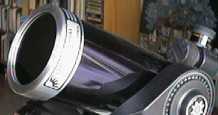 After decades of just looking at the Sun at sunset and doing eyepiece projection onto pieces of paper or white cardboard, and enthused by comments from other ETX users (see the next review for an example), I finally decided to get a solar filter. I called Thousand Oaks (800-996-9111 or 805-491-3642) and received excellent assistance in ordering just what I needed for my ETX (they said their ETX filters are very popular right now). Since I wanted it for both visual and photographic use I went with the Type 2 Plus, which has a transmission factor of 1/1000 of 1% (ND-5). (There is also a Type 3, which is a lighter density (ND-4) and for photographic use only.) The filter is glass, coated (reflects like a mirror), felt-lined for a slip-on but secure fit on the ETX (see photo), and provides a nice yellow-orange view of the Sun. Some basic care, usage, and photography instructions are included. Unlike in Paul Boudreaux's review (next), I did not have to touch up any defects. This is a quality, safe product, and I recommend Thousand Oaks to anyone wanting a solar filter. And speaking of safety, in the photo you can see a finderscope cover I made from cardboard and black masking tape. It is strongly recommended that you cover the finderscope to avoid burns, eye damage, or other problems. Photos of the Sun are now showing at the Sun Gallery. After decades of just looking at the Sun at sunset and doing eyepiece projection onto pieces of paper or white cardboard, and enthused by comments from other ETX users (see the next review for an example), I finally decided to get a solar filter. I called Thousand Oaks (800-996-9111 or 805-491-3642) and received excellent assistance in ordering just what I needed for my ETX (they said their ETX filters are very popular right now). Since I wanted it for both visual and photographic use I went with the Type 2 Plus, which has a transmission factor of 1/1000 of 1% (ND-5). (There is also a Type 3, which is a lighter density (ND-4) and for photographic use only.) The filter is glass, coated (reflects like a mirror), felt-lined for a slip-on but secure fit on the ETX (see photo), and provides a nice yellow-orange view of the Sun. Some basic care, usage, and photography instructions are included. Unlike in Paul Boudreaux's review (next), I did not have to touch up any defects. This is a quality, safe product, and I recommend Thousand Oaks to anyone wanting a solar filter. And speaking of safety, in the photo you can see a finderscope cover I made from cardboard and black masking tape. It is strongly recommended that you cover the finderscope to avoid burns, eye damage, or other problems. Photos of the Sun are now showing at the Sun Gallery. |
|||
| Solar View Type A Plus solar filter | Thousand Oaks | N/A | $65 |
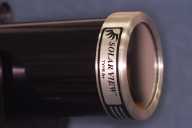 Paul J. Boudreaux (boudreau@eng.umd.edu) reports: "I recently purchased a Thousand Oaks SOLAR VIEW TYPE A PLUS solar filter for the ETX. It is an easy slip-on attachment that uses a felt liner on the filter frame to form a friction mount to the front of the telescope. After following the instructions to check for tiny pinholes of light in the filter, I used a straight pin dipped in black paint to place a small dot of paint over the pinhole on the rear side of the filter. It was an easy task. Even if you smear the paint, it can be removed with fingernail polish remover and a cotten swob because the stainless steel coated filter is a hardy film. In minutes I was up and running. As a hint to other readers, when I inquired to various vendors about solar filters and asked for their catalogs prior to my purchase, they often sent a free sample of a film based solar filter material (usually a few square inches in area). I used this filter "foil" with a plastic cap from a spray paint can to make a solar filter for the Finder Scope on the ETX. I cut out a 3/4 inch diameter hole in the top of the plastic cap and glued the film filter over the hole. This cap then could be slipped over the end of the finder scope on the ETX to align the telescope with the sun. It works great! Source: Pocono Mountain Optics Cost: $65 and no shipping charges." Paul J. Boudreaux (boudreau@eng.umd.edu) reports: "I recently purchased a Thousand Oaks SOLAR VIEW TYPE A PLUS solar filter for the ETX. It is an easy slip-on attachment that uses a felt liner on the filter frame to form a friction mount to the front of the telescope. After following the instructions to check for tiny pinholes of light in the filter, I used a straight pin dipped in black paint to place a small dot of paint over the pinhole on the rear side of the filter. It was an easy task. Even if you smear the paint, it can be removed with fingernail polish remover and a cotten swob because the stainless steel coated filter is a hardy film. In minutes I was up and running. As a hint to other readers, when I inquired to various vendors about solar filters and asked for their catalogs prior to my purchase, they often sent a free sample of a film based solar filter material (usually a few square inches in area). I used this filter "foil" with a plastic cap from a spray paint can to make a solar filter for the Finder Scope on the ETX. I cut out a 3/4 inch diameter hole in the top of the plastic cap and glued the film filter over the hole. This cap then could be slipped over the end of the finder scope on the ETX to align the telescope with the sun. It works great! Source: Pocono Mountain Optics Cost: $65 and no shipping charges."
Dave (AstroFrk69@aol.com) reports: "I just want to inform you that I just received my thousand oaks type A+ solar filter for my etx. When I got it I was thrilled. I opened it up, read the instructions, and couldn't wait to try it out. I brought everything outside (my scope, eyepieces, etc...) to cool down. It was about 9 in the morning and I had everything set up for my first view of the Sun. I placed the filter on the scope, (you have to keep checking it because it can slide off even with the extra felt inside of it), I then covered the finderscope. this is very important. You can accidentally look through it and blind yourself, not only ruining your eye sight, but the finderscope as well. I placed a little cover thingy on the front of the finderscope which "turned it off." Using a 22mm panoptic eyepiece (yes it fits in the etx), I started "searching" for the Sun. You have to scan the sky for the sun because you have no guide. Out of no where, there she was. Wow. That is the only word I can say to my reaction of first seeing it. The sunspots were easily visible. I put in my 9mm nagler with a barlow and got a closer look at the sunspots. The etx held up beautifully. The images were crisp and perfectly clear, and there was no fuzz. This scope and filter are amazing. If you're getting an etx, or already have one, definitely get a solar filter. It is astounding." |
|||
| Narrowband Filter | Meade | 908N | $90 |
| Adolfo Viana (aviana@impsat.net.co) provided the following comments: "I recently got a Meade Narrowband filter, since here in Bogota we have a well poluted area, one of my first targets was M57, that night we were using the ETX and a LX50 8", with the use of the filter the image was very clear through the ETX, the big difference with the LX50 was in the apparent size, both observations were with the Meade 26mm SP." | |||
| ETX SOLAR SKREEN | Tuthill, Inc. | N/A | $48 |
| Don (TheDBarbee@aol.com) notes the following about the ETX SOLAR SKREEN from Roger Tuthill (800-223-1063 or 908-232-1786). "Wow this is a GREAT product. The views of the Son are just mindboggling. Worth every penny. The Solar Screen is $48.00; there is shipping."
Douglas E. Cann (cann@axionet.com) adds "Just wanted to share my latest accessory that I received for my vintage ETX (July 1996) which is still performing flawlessly. I bought one of Roger Tuthill's Solar Skeens for viewing the sun. This will now double the use of my ETX. The sun is getting pretty active right now and I wanted to get the filter before there is a rush on them. The 90 mm ETX is the perfect size for solar observation and my first test run on the weekend confirmed this. It is a mylar filter and although I was torn between this and one of the glass filters, I decided on the mylar one for weight and after hearing various reports and reading the write up in Sky and Telescope last summer. The light blue image of the sun is no problem and although I experimented by adding different colored filters to my eyepieces, the solar filter on its own gave the best details. A light green filter 'may' improve the contrast. I will have to wait for another sunny day. Anyway, I am very pleased with its perfomance and would reccomend this filter to all ETX owners." |
|||
| Photo-Visual Color Filter #8, Light Yellow | Meade | 07512 | $18 |
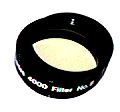 From the Meade specs: "(83% transmission): Useful in observing red and orange-colored phenomena in the belts of Jupiter, and in enhancing the level of observable detail of small orange-red zonal features within the belts of the planet. Increases the contrast of maria on Mars. ... A popular filter for the enhancement of lunar features...". So far, I've only used this filter on Jupiter, Saturn, and the Moon. Jupiter was sitting close above a building and so seeing was hampered by heat waves from the roof. I'm not able to give a valid report at this time for use of this filter on Jupiter. On the other hand, this filter did enhance the belts of Saturn and made one in particular more prominent. The nearly First Quarter Moon was made a little crisper but not significantly so. I have done a test on the Full Moon; the results are shown in the Moon Gallery. From the Meade specs: "(83% transmission): Useful in observing red and orange-colored phenomena in the belts of Jupiter, and in enhancing the level of observable detail of small orange-red zonal features within the belts of the planet. Increases the contrast of maria on Mars. ... A popular filter for the enhancement of lunar features...". So far, I've only used this filter on Jupiter, Saturn, and the Moon. Jupiter was sitting close above a building and so seeing was hampered by heat waves from the roof. I'm not able to give a valid report at this time for use of this filter on Jupiter. On the other hand, this filter did enhance the belts of Saturn and made one in particular more prominent. The nearly First Quarter Moon was made a little crisper but not significantly so. I have done a test on the Full Moon; the results are shown in the Moon Gallery. |
|||
| Photo-Visual Color Filter #82A, Light Blue | Meade | 07521 | $18 |
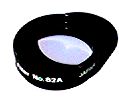 From the Meade specs: "(73% transmission): Useful on the Moon, Mars, Jupiter, and Saturn, this subtle pale blue filter enhances areas of low contrast while avoiding significant reduction of overall image brightness." So far, I've only used this filter on Jupiter, Saturn, and the Moon. Jupiter was sitting close above a building and so seeing was hampered by heat waves from the roof. I'm not able to give a valid report at this time for use of this filter on Jupiter. When used on Saturn, there was no noticeable difference. The nearly First Quarter Moon was made a little crisper, but like with the Light Yellow Filter, not significantly so. I have done a test on the Full Moon; the results are shown in the Moon Gallery. From the Meade specs: "(73% transmission): Useful on the Moon, Mars, Jupiter, and Saturn, this subtle pale blue filter enhances areas of low contrast while avoiding significant reduction of overall image brightness." So far, I've only used this filter on Jupiter, Saturn, and the Moon. Jupiter was sitting close above a building and so seeing was hampered by heat waves from the roof. I'm not able to give a valid report at this time for use of this filter on Jupiter. When used on Saturn, there was no noticeable difference. The nearly First Quarter Moon was made a little crisper, but like with the Light Yellow Filter, not significantly so. I have done a test on the Full Moon; the results are shown in the Moon Gallery. |
|||
Go back to my ETX Home Page.